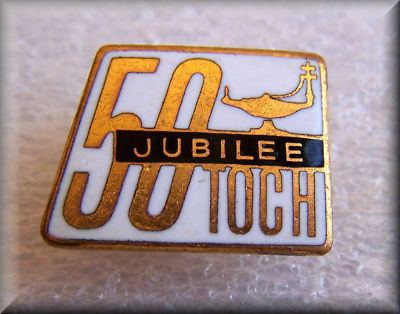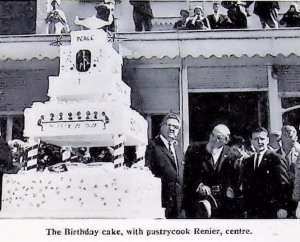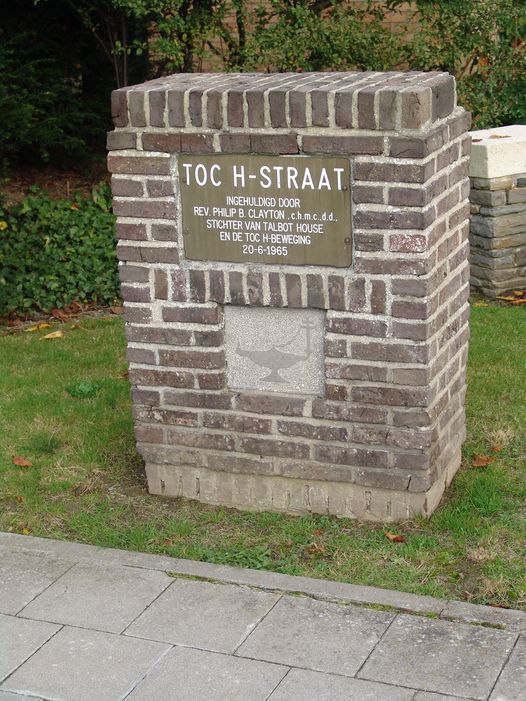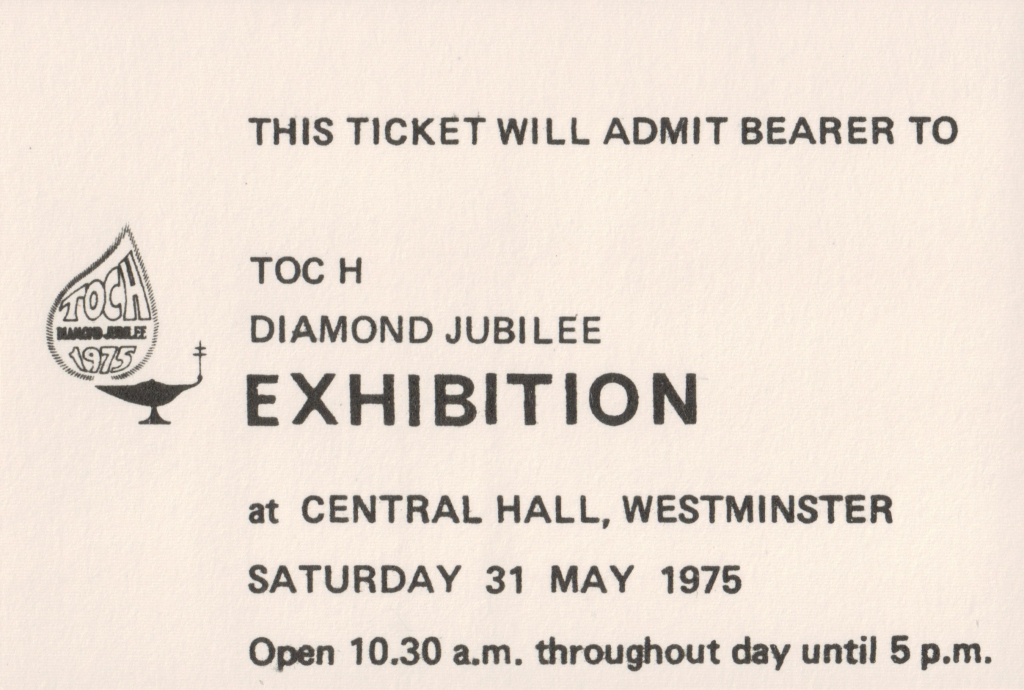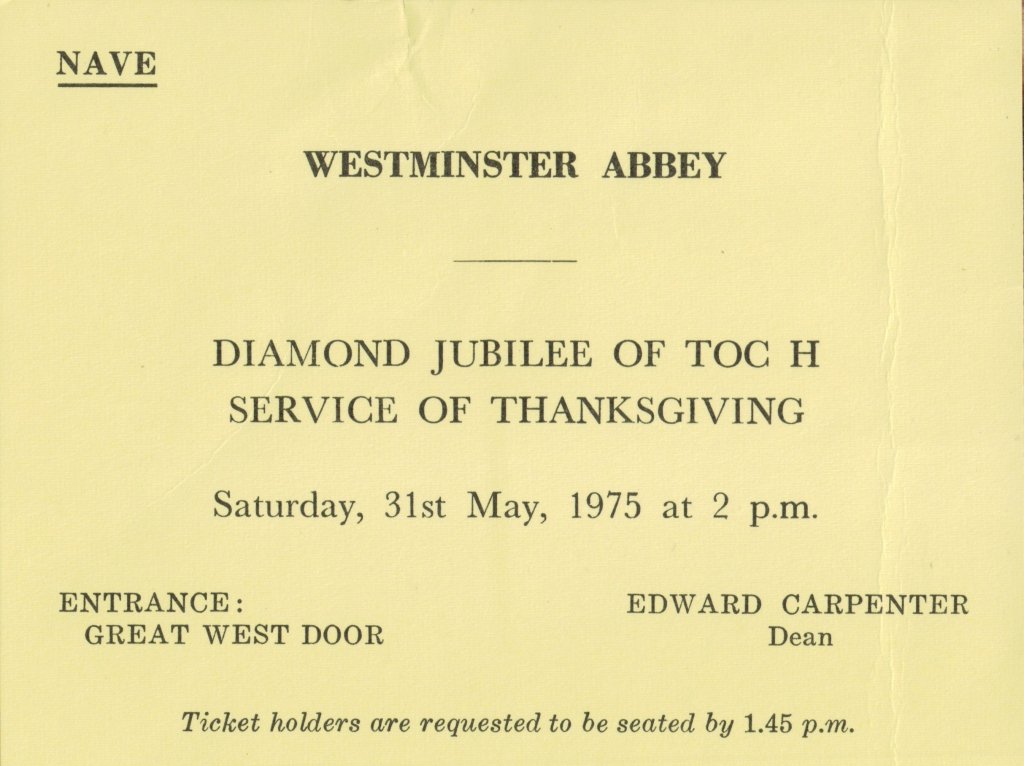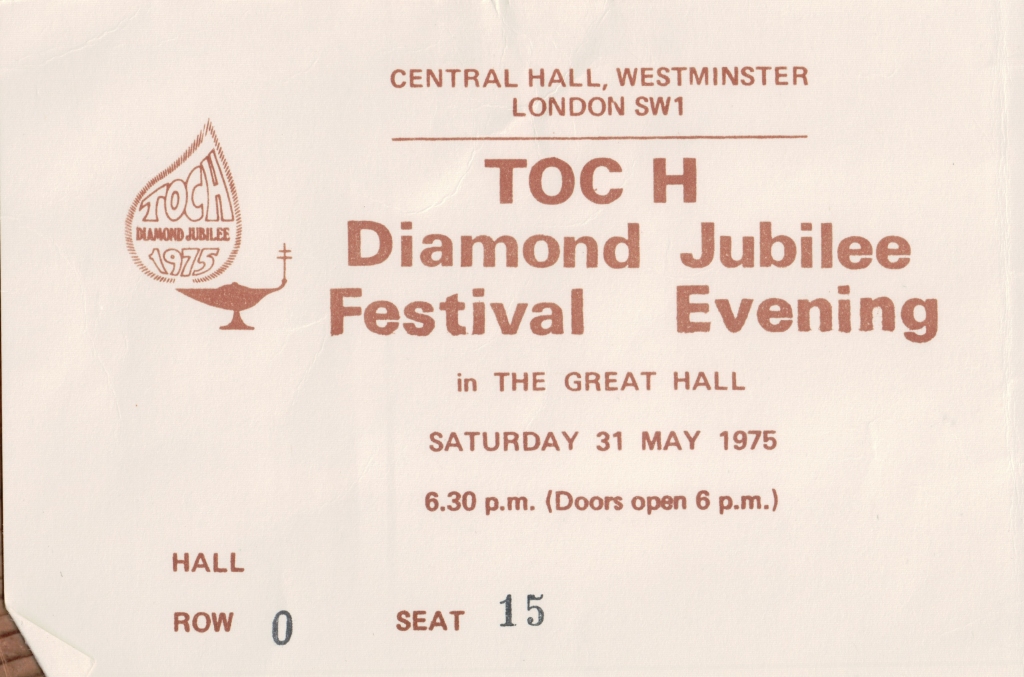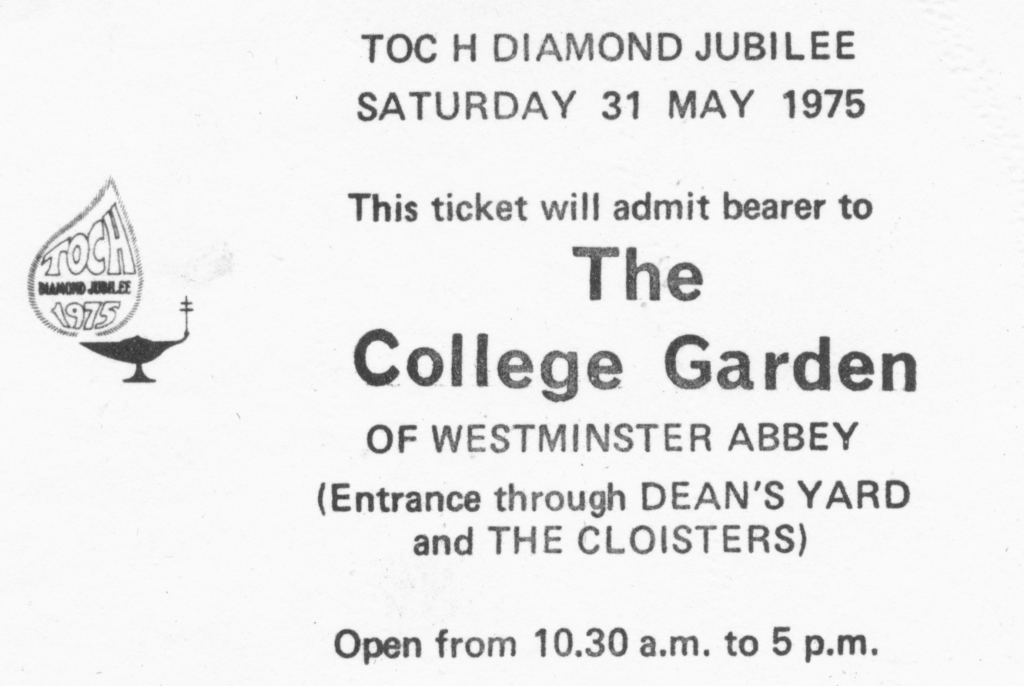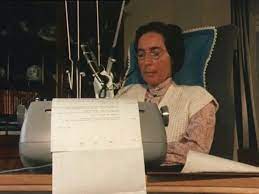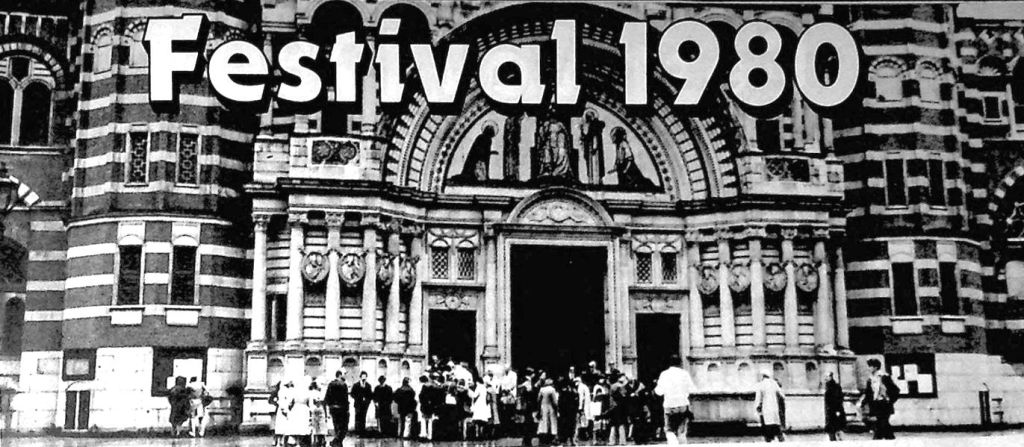By Steve Smith
This is the second part of our look at Toc H Birthday festivals. Once again, I have uploaded many programmes and other related materials to the Internet Archive and links to these brochures are included in the text.
As we saw in part one, the Toc H Birthday festivals were huge events in the pre-war years. After Hitler interrupted the proceedings, could they ever return to their former glory? We had to wait until 1948 to find out.
There were local and regional festivals held in the immediate post war years, including a fairly low key event in London in 1946. This comprised a small gathering ‘by invitation only’ at Mansion House, where Henry Willink, and Percy Hugh Beverley Lyon (Headmaster of Rugby) stirred those members lucky enough to be present, into post-war action. Then, as local areas organised their own Thanksgiving Services, London members flocked to Westminster Abbey for a service there on Wednesday 11th December. This included a Lamp Lighting at Church House, as part of the World Chain of Light which had begun at the Services Club in Berlin.
1946 Birthday Festival ( Service Of Thanksgiving Westminster Order Of Service)
So the first true post-war national Festival in a decade took place in London, over the weekend of the 11th and 12th of December 1948.
It was at once, both the same and different from the pre-war Festivals. On Saturday afternoon, the Thanksgiving Service was held, not in the great cathedrals of London, but in the Royal Albert Hall itself, normally reserved for the Festival evening. Austin Williams led the service then George MacLeod gave a memorable address.
The feeding of the masses after the service was trickier. Not only was London still badly affected by the Blitz but new Catering Wage Acts meant that employees had to be paid more at weekends which led to many establishments opening only from Monday to Friday. In the end, Toc H persuaded the Albert Hall caterers to provide tea and snacks from their bars around the venue.
This at least meant that the hordes did not have to rush across London between events and simply waited for the hall’s bells to signify that the evenings events were about to begin. This turned out to be the start of the World Chain of Light (brought forward from its normal 9pm to 6pm to fit in with the rest of the evening). The chain began in London at the Royal Albert Hall and spread westward until it circled the entire girth of the planet twenty-four hours later. It was kindled from the Prince’s Lamp which was solemnly carried in by the General, Arthur Pettifer himself.
Then the entertainment began with Phillip Slessor (a BBC announcer and the son of Paul Slessor), introduced the singer Camilla Castelli who performed three numbers before Sam Costa, the much-loved star of BBC radio’s Much Binding in the Marsh, gave a comic performance to the assembled throng. It fell to chairman of the Central Executive, Morley Jacob, to follow Costa and deliver a more sober speech which updated members on the activities of Toc H in recent months. A new Festival Masque entitled I Believe – once again written by Barclay Baron – followed and completed the evening.
Incidentally, the war had left London terribly short of accommodation, and many out-of-town members spent the night at the Clapham South Leave Hostel aka Clapham South Deep Shelter. The former wartime air-raid shelter built in Clapham tube station had, earlier in 1948, been home to those migrant workers who arrived from the Caribbean on the MV Windrush, and three years later would be used as a cheap hostel for visitors to the Festival of Britain.
On Sunday morning, the burned out and bomb damaged All Hallows could only support a small communion so many celebrated at the Church of the Ascension in Balham. Later, All Hallows was again supplemented by other City churches at St Mary-at-Hill in Lovat Lane, and St Botolph’s, Bishopsgate. The Methodists descended on Wesley’s Chapel, near Old Street, swelling the normal congregation there by some 400 souls.
After lunch, the Family Gathering took place in the Empress Hall, part of the Earls Court exhibition centre. Normally an ice rink, Toc H hung signs from the ceiling marking areas such as P.O.W., B.A.O.R, and S.E.A.C. where members could assemble and meet old friends they knew from these theatres of war. This emphasised how much the war had changed things. After allowing some time for chatting and circulating, the more formal afternoon began with community singing. It was followed by an array of speeches. In typical Toc H fashion these were delivered by speakers as diverse as Sir Frederick Bain, the chairman of ICI, and John Watson, a Leicestershire miner.
Following prayers, the crowds surged out on to the streets of London. After a ten-year hiatus, the Toc H Festival was well and truly back.
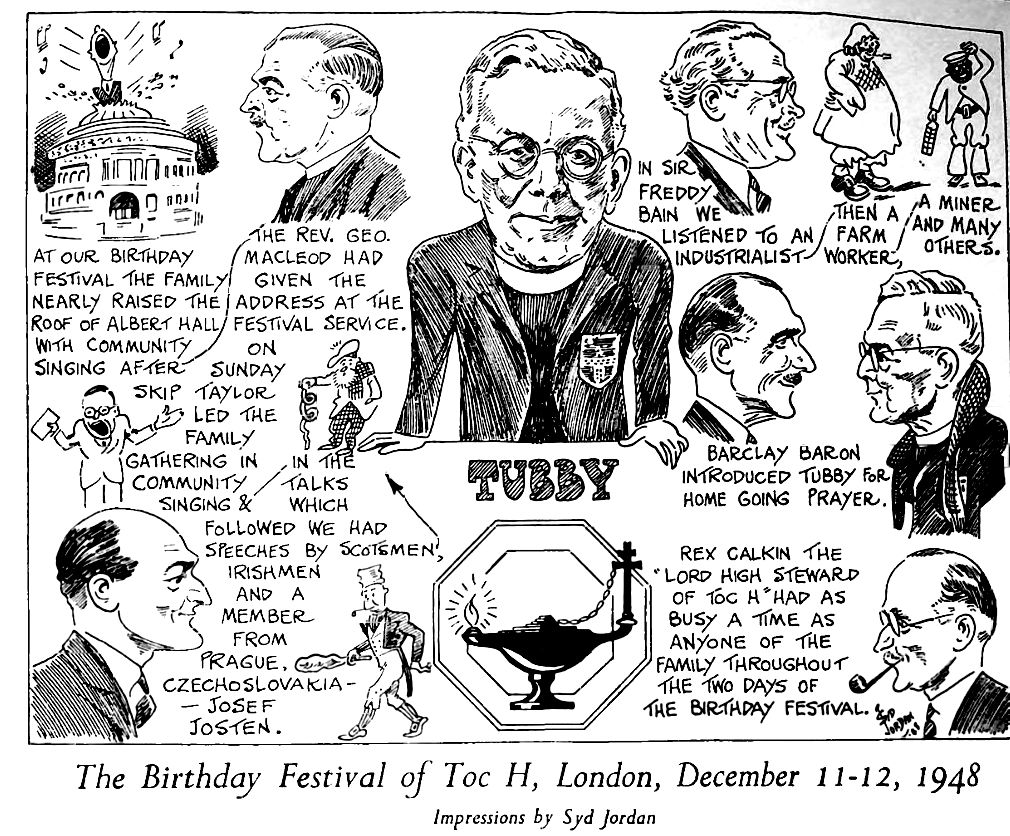
In the spring of 1949, it was decided that there would be no national Festival that year and the next was pencilled in for October 1950. This signalled the end of annual Birthday Festivals.
In fact, the 1950 Festival would be held in November, on Saturday 18th and Sunday 19th to be precise, so not truly a Birthday Festival. On the Saturday, Toc H once again brought the normally ‘dead on winter weekend’, Tower Hill to life. Some 5,000 members were streaming to services at St Paul’s, Wesley’s Chapel, and Southwark Cathedral. St Paul’s, standing proudly and largely untouched by the Luftwaffe, held the most with 2,400 people watching no less than fifty Toc H padres process in their robes with the Lord Mayor and his Sheriffs trailing behind.
Afterwards, the Royal Albert Hall once again hosted the Festival Evening, it’s limited capacity now managed by strict ticket allocation. The Brentford and Chiswick Musical Society opened proceedings at 7pm and were followed by Peter Brough and Archie. Younger readers will not be familiar with Brough, a ventriloquist whose normal media was radio!
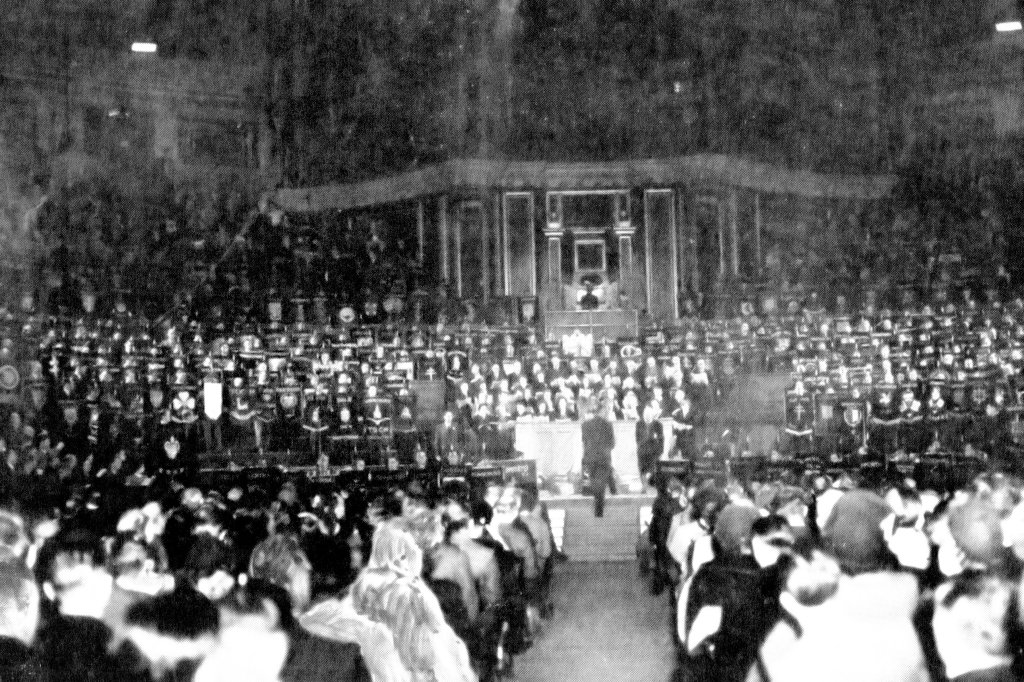
The array of banners in the Royal Albert Hall (1950)
Morley Jacob opened the speeches and addresses, which ended with a message from their Patron, King George. No-one knew it at the time, but it would be the last Royal Address from the King at a Toc H Festival.
After an interlude, it was time for the masque. Credo was a revised version of Baron’s 1948 play. The story is, very simply, about the battle between good and evil – with many of the cast provided by the London Academy of Music and Dramatic Art – and in the final scene the actors representing good and evil are on stage for their final ‘battle’. The very last line of the masque is “Come all ye faithful”, at which point a procession of Toc H banners streams into the hall. They are followed by the Gen bearing the Prince of Wales’ Lamp as usual, and then Tubby’s voice booms out the word Light!, as the ceremony closes the evening’s happenings at 9pm sharp.
Sunday’s Family Gathering was held at another venue, new to Toc H, which was the Lyceum on the Strand. Special guests included Marcel & Yvonne Derynck. Yvonne visited Talbot House for Tubby’s Christmas party in 1916, and the couple now lived next door to the Old House and did much for it. Sadly missing was Sir Frederick Bain, who for many years had chaired the Festival Committee. He lay dying in hospital but did send a humorous message, that was read out.
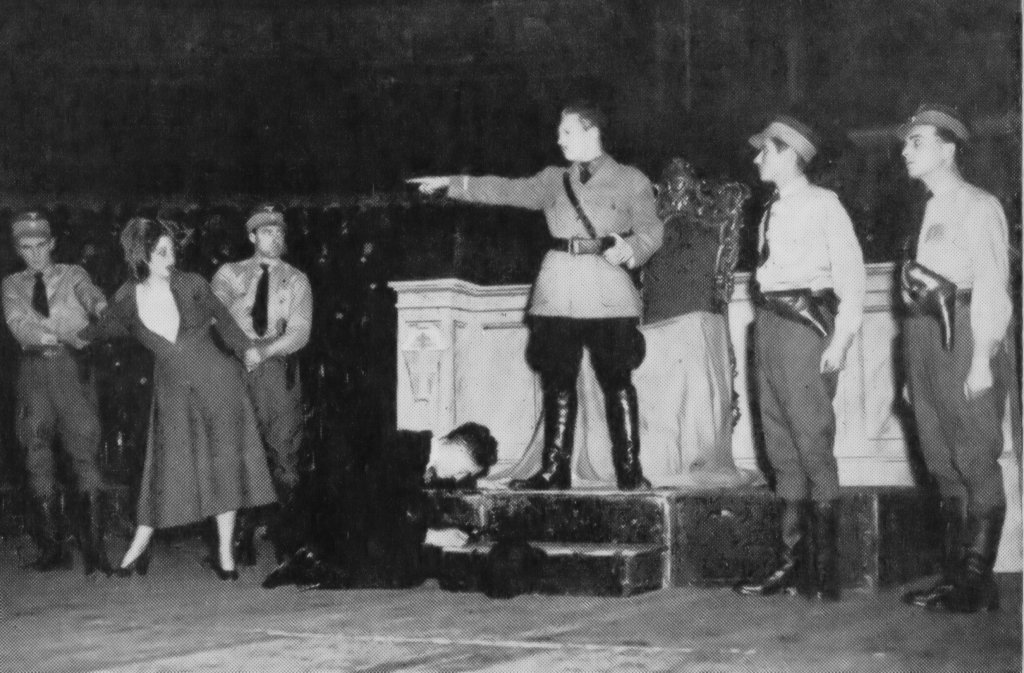
The battle between good and evil – the 1950 masque
A different Festival concerned Toc H – and indeed the whole of Britain and the Commonwealth – in 1951 as the Festival of Britain sought to lift the people from the post-war gloom. Toc H were as involved as everyone in the country and thus confined their own Festivals to area and District events. In fact, they would wait 2½ years before they next held a national Festival.
This Festival was once again seasonly-shifted to June 1953 and took place on 13th and 14th. What was not known, when these dates were fixed, was that they would come just a fortnight after Queen Elizabeth II was crowned. So as Toc H entered the new Elizabethan age, it was perhaps appropriate that the main gathering on Saturday afternoon was take place at the freshly minted Royal Festival Hall, built for the Festival of Britain. Funny to think that almost 50 years later I would regularly meet my fellow Toc H members of the South East Region Projects Committee, in the café here.
The crowds assembled outside the hall from 1pm. Unfortunately, this was England; June sunshine was distinctly lacking and the crowd were being rained upon when the doors opened at 2pm.
Toc H were embracing the new age and, given that places were as limited as ever, they encouraged branches to send younger members as representatives, and insisted that the banner bearer should be the youngest member or probationer of the branch.
Proceedings began with the National Anthem at 3pm. Quite possibly the first time many people present had ever sung God Save the Queen. There followed speeches, including the inimitable Tubby, then a new masque – The Bridge – from the creative genius of Barclay Baron as usual. Then a rousing rendition of Jerusalem by the assembled masses, more baritone than you would get at a Women’s Institute meeting I assume. The Ceremony of Light concluded the afternoon
Being June, the Saturday evening event was scheduled to be held outdoors at Hyde Park. The afternoon’s rain had ceased, and though it couldn’t be considered a glorious English summer evening, it did at least stay dry. This must have pleased Pat Leonard and several other senior staff who were rounded up by a ‘mob’ from the London Marks, and held captive in the Cockpit. Perhaps because of his age (64), the mob underestimated Leonard’s renowned sporting prowess, and the shortly to be appointed suffragan Bishop of Thetford, swerved and dodged the youngsters to make his escape. The purpose of this event escapes me, but I believe all who took part enjoyed themselves.
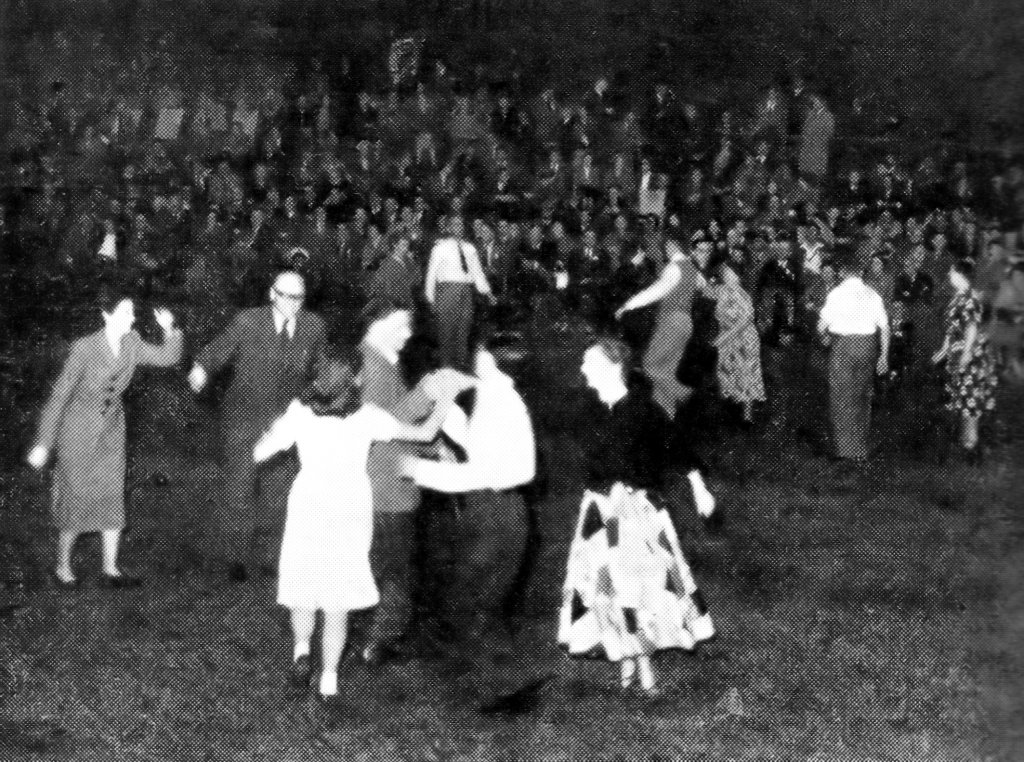
Square dancing in the Hyde Park Cockpit (1953)
Square dancing then gave more of the spectators the opportunity to take part, after which the skirl of the pipes heralded the procession of banners. Another opportunity to get the words of the national anthem correct, closed proceedings for the evening and the crowd melted away just as the first drops of rain began to descend.
On Sunday the focal point became Tower Hill and services were held at various city churches, including All Hallows which was being dragged phoenix like from the ashes. An early communion was held here followed by breakfast at 42 (Talbot House on Tower Hill).
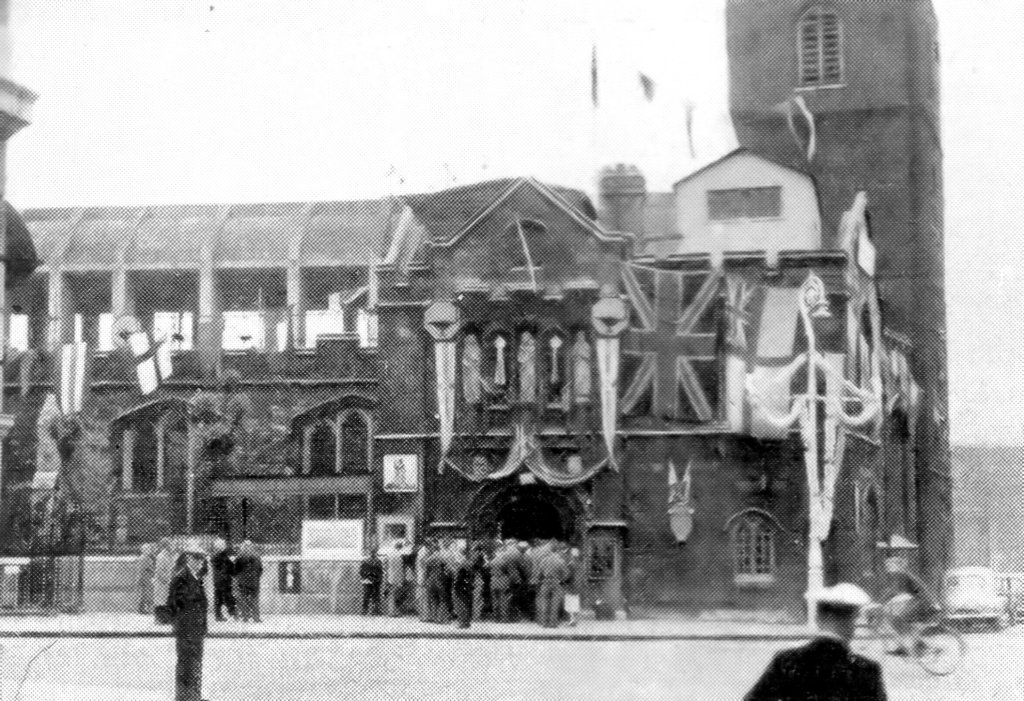
All Hallows, still bedecked for the Coronation (1953)
On Sunday afternoon, Westminster Abbey, still dressed for the Queen’s Coronation, housed the Festival Service which closed the weekend.
Moving the Festival to June in 1953 seemed to mark a sea change for the celebration. No longer was it to routinely be a Birthday Festival in December but now was the Toc H British Festival, at a generally warmer time of the year. Thus in 1955 it was set to take place in April, at the same time as the Australian Festival was occurring on the other side of the world.
It opened on St George’s Day, April 23rd of course, with members asked to meet up in St James’ Park from 2pm. On this occasion, April sunshine put a brilliant glow on the afternoon. Then onto services at Westminster Abbey and Westminster Chapel at 5pm. The Festival Evening was at the Royal Albert Hall with the London Toc H Male Voice Choir providing just one part of the entertainment.
On Sunday, after the usual services a Family gathering took place in the Royal Horticultural Society’s hall, Westminster. Its space was limited and whilst 600 sat on chairs, another 500 squatted on the floor on tiny cushions. They heard from many speakers including a raft of overseas visitors, and Tubby himself, before the 1955 Festival closed.
Despite the success of the Spring Festival, the 1957 event returned to the traditional December, taking place on Saturday and Sunday the 7th and 8th of December.
Notwithstanding the rain, crowds were swarming over Tower Hill on the Saturday morning. There were guided tours of the recently rebuilt and rededicated All Hallows, and coffee on tap at Crutched Friars House. The rain eased in the early afternoon as pipers led the parade of banners down Seething Lane into All Hallows for a service. Then everyone headed for Westminster Abbey (and Chapel for the overflow) for the Thanksgiving Service at 4pm.
Order of Service Westminster Abbey
Order of Service Westminster Chapel
There was just time to grab a quick bite before the doors to the Royal Albert Hall opened at 7pm, for a 7.30pm sharp start. The joy and light of the evening was temporarily stifled whilst the ninety dead and scores of injured at the Lewisham train crash three days earlier were remembered. Speeches abounded and a new masque, Listen, was unveiled. For a change it was not written by Baron but devised by Oliver Wilkinson. Baron though, was the first voice heard, on a tape recording since he was touring the Middle East.
The normal services on Sunday morning were followed by a Family Gathering at Queen Mary College, part of the University of London. This was formerly the People’s Palace, not the original which Toc H used back in 1929, since that burned down in 1931, but its replacement which was acquired by the University in 1954.
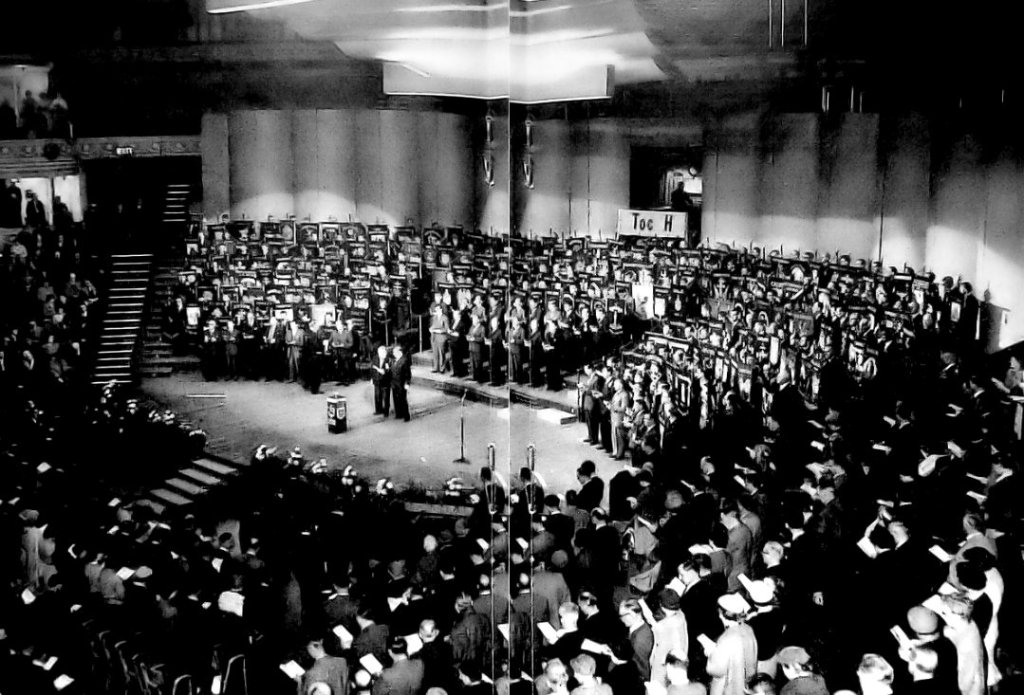
The banners assembled, Royal Albert Hall (1957)
It would be a five year wait for the next National Festival; well 4½ to be more accurate since it moved to June again in 1962. It began on Saturday 16th June with a meet up on Tower Hill. The London Marks were also keeping open house but members were particularly encouraged to visit the newly opened Prideaux House in Hackney, the latest incarnation of Mark III (See here). This was the first ever purpose-built Mark and Toc H were rightly proud of it.
Lunch was served at noon at 42 (strictly ticket holders only) followed by more mingling on Tower Hill prior to the services starting at 3pm. This year they were split between All Hallows, St Martin in-the-Fields, Hinde Street Methodist, the Temple Church, and the City Temple.
The Royal Albert Hall, as usual, hosted the Festival Evening. The usual music, community singing, speeches, Ceremony of Light, and banner procession filled the evening as there was no masque this year.
On Sunday – Trinity Sunday – there were no less than five services at All Hallows beginning with Communion at 8.30am (the Free Church Communion was actually held in the Porch Room). The Family Gathering on Sunday afternoon was held at Royal Festival Hall and concluded at 4pm, after which tea was available.
There would be another three-year wait until the next Festival but it would be worth waiting for. 1965 would be the 50th Anniversary of Talbot House first opening its doors and huge celebrations were being planned for the year. In fact, it would not just be a National Festival because International elements were being planned, notably in Poperinge.
One of the first events – in April – combined both London and Poperinge, since it was a race to get from the Tower of London to Talbot House, and back again. The twist was that the competitors (boys of 17 or older from affiliated schools) had to pass through checkpoints at Dover and either Calais or Ostend, and could spend a maximum of £6 including the crossing! The winners were Nick Slater and Morris Fairhurst from Worksop College who did the return trip in 24 hours.
This photo is from the Westhoek Region heritage bank though it doesn’t name the boys pictured
The bigger part of the proceedings focussed around a national Festival in London from Saturday 15th to Sunday 23rd May. This was to be a Festival unlike its predecessors, even the Coming-of-Age Festival at Crystal Palace 29 years earlier.
It began on the Saturday with a sports day in Battersea Park in the afternoon, and then former Marksmen held a reunion at the Corn Exchange in the evening (including a visit to the Sunday Times offices).
The badge created for the Jubilee (1965)
Two services at All Hallows began the Sunday. The 10.30am service was televised live by the BBC as Morning Prayer, and Princess Alexandra was in attendance. Tubby, now retired as vicar of All Hallows, watched from the Sanctuary as Colin Cuttell led the service. Sir Thomas Butler, Governor of the Tower Of London, took Light, using the (slightly controversial) newly introduced, alternative form of words adapted by Alan Paton from the prayer of St Francis.
Open House at the various Toc H premises on and around Tower Hill filled the rest of the morning then the afternoon was taken up by a Garden Party at Windsor Castle (with kind permission of Her Majesty the Queen). The band of the Welsh Guard played in the background. Walter H. de Sagher, the Burgomaster of Poperinge performed the official opening. Angus Ogilvy was also in attendance. Evensong was held in St George’s Chapel.
Monday saw visits to the Stock Exchange, the Evening News, and the Daily Mail whilst that night the Lord Mayor, Sir James Miller, and the Corporation held a reception for Toc H at the Guildhall. Princess Alexandra and Angus Ogilvy were again the guests of honour.
Tuesday was filled with more visits to newspaper offices; a conference at Bakers’ Hall on the theme of Working Together; a river trip to Greenwich; a guided walk around the City; and a Guest Night at Coney Hall.
Wednesday’s trips included the Houses of Parliament, Harold MacMillan’s home of Birch Grove in Sussex, and another Historic London tour of the City. The Othona Community hosted a party at St Michael’s Vestry, and there was a Warden Manor reunion at Toc H headquarters.
Thursday’s delights included a second conference (Living Together), this time at Shoreditch Town Hall, lunch at Prideaux House, another City tour, a visit to the Kodak works and museum, a coach trip to Guildford, and a visit to the Croydon Centre.
Friday saw a repeat visit to Kodak and a visit to the Daily Telegraph. The coach this time left for Canterbury, and in the evening, there was an Old House reunion in Goldsmith’s Hall. This was followed by a Celebrity Concert in the Royal Festival Hall.
The main weekend then bore similarity to previous years with Thanksgiving Services at St Paul’s and the City Temple at 12noon.
The multitude then assembled in the moat at the Tower of London for an informal gathering. There was a small reception at Baden-Powell House, and – after high tea at Kensington for the lucky few with tickets – the Festival Evening began at the Royal Albert Hall. The Honourable Angus Ogilvy, Vice Patron of Toc H, was present.
Music opened the show with an organ recital by Arnold Greir, then a fanfare by the combined bands of BMC (Morris Motors), and Hanwell Town band (you might know them as the band that later played on Terry Wogan’s the Floral Dance, and Peter Skellern’s You’re A Lady – Skellern of course was a Marksmen at Mark III in the late sixties but I’m getting sidetracked).
After messages from General Secretary Cyril Cattell, music returned firstly from the above combined bands then – with a bit of a difference – a pop band. The act in question were Danny Cannon and the Ramrods. Since music was the first thing I ever researched and wrote about professionally, I have long wanted to cover this combo’s brief sojourn with Toc H. They were sponsored by Bilston branch from the West Midlands and this is how they got involved. Formed in 1959 as five schoolfriends devastated by the death of Buddy Holly, the original band were Danny Robinson, Ken Hooper, Alan Lacey, Len Beddow and Pete Walton. They struggled to find venues in Bilston but eventually ended up rehearsing in the Toc H Branch rooms, which were isolated and meant you could make as much noise as you wanted. The connection was made by Len Beddow’s father, Ernie, who was a member of the Branch. Interestingly, another local band known as the N’Betweens also rehearsed here. They later went on to become better known as Slade. And if you really want to drown this in trivia, Slade played at Cuffley Youth Centre just as they became a global sensation. Cuffley Youth Centre was where I met Toc H, and where the Lea Valley Branch were based!
It was then a logical step for Bilston Branch to propose that the band played at the Jubilee festival, which they did.
After the Toc H show, the band changed their name to Herbie’s People and their story was one of ‘we almost made it’. Their manager, Bill Bates, was the brother-in-law of the well-known songwriter Ken Lewis. This gave them access to potential hit songs and in 1966 they recorded a song Lewis had written with Geoff Stephens. It was called Semi Detached Suburban Mr Jones but before they could release it, a chart-topping band called Manfred Mann recorded a version (changing Jones to James, as singer Paul Jones had just left) and had a smash hit with the song. To make things worse Lewis, this time with John Carter, wrote Let’s Go To San Francisco for Herbie’s People but the songwriters liked it so much they recorded it themselves (as the Flowerpot Men) and thus deprived the band of another big hit. Herbie’s People got a very positive reception but never quite managed to turn it into sales. Nonetheless, thanks to Toc H, they did at least get to play the Royal Albert Hall, and in return the boys all volunteered for Toc H.
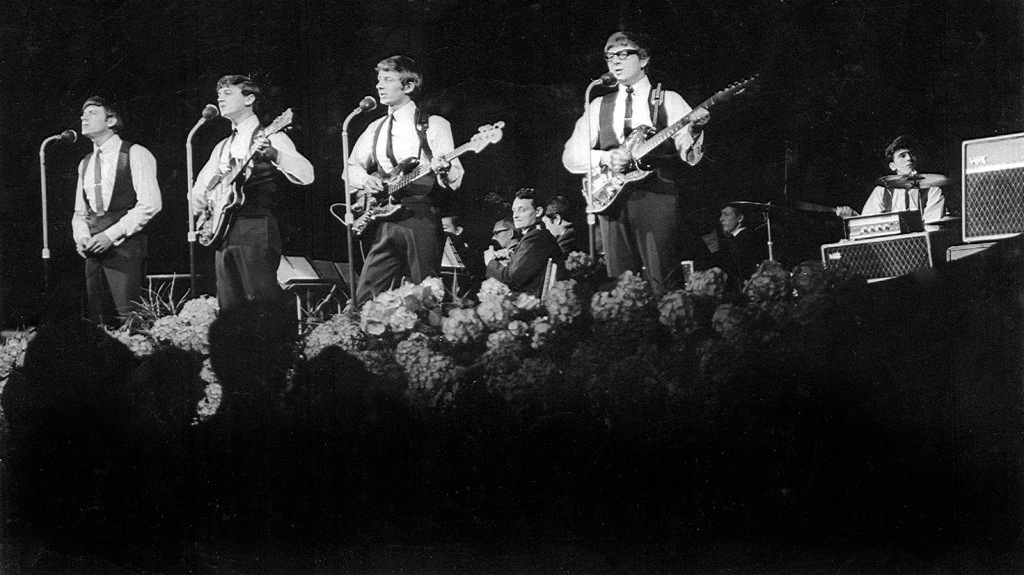
The Ramrods (1965) Photo courtesy Michael Taylor
After the ‘pop’, Brian and Cynthia performed some folk music before music gave way to a pictorial presentation of the history of Toc H, entitled The End of the Beginning. The commentary was recorded by Roger Collinge, and Ken Prideaux-Brune. Speeches, the lighting of Lamps, and prayers concluded the evening.
Sunday brought this part of the celebrations to a close with services at All Hallows
An Art Exhibition in the Tate and Lyle Room at 41 Trinity Square (Wakefield House) and a Toc H Mobile Exhibition (on Tower Hill) were running throughout.
Then attention turned to Belgium. For the British contingent, this next part of the celebrations began, as it often did, at Victoria station. Here, on Friday 18th June, Toc H ties and blazers could be seen in abundance. Not just British members, as many overseas visitors had planned a lengthy stay in Europe to attend the national Festival and the Poperinge celebrations. Thus, it was a truly international body of men and women who crammed into the boat trains and crossed the channel for the weekend.
Here, they were greeted by their hosts, a plethora of locals offering accommodation over the weekend. And Poperinge was ready. As the Journal described it:
A riotous blaze of colour – Union Jacks, Belgian flags, Flanders pennants, coats of arms, festoons, bunting, coloured lights, and hundreds of Jubilee ‘stickers’ in the windows of the houses and shops.
There were feasts and banquets at Skindles, the Palace Hotel, and the Cloth Hall in Ieper. Music from Poperinge bands and the band of the Royal Fusiliers filled the Grande Place.
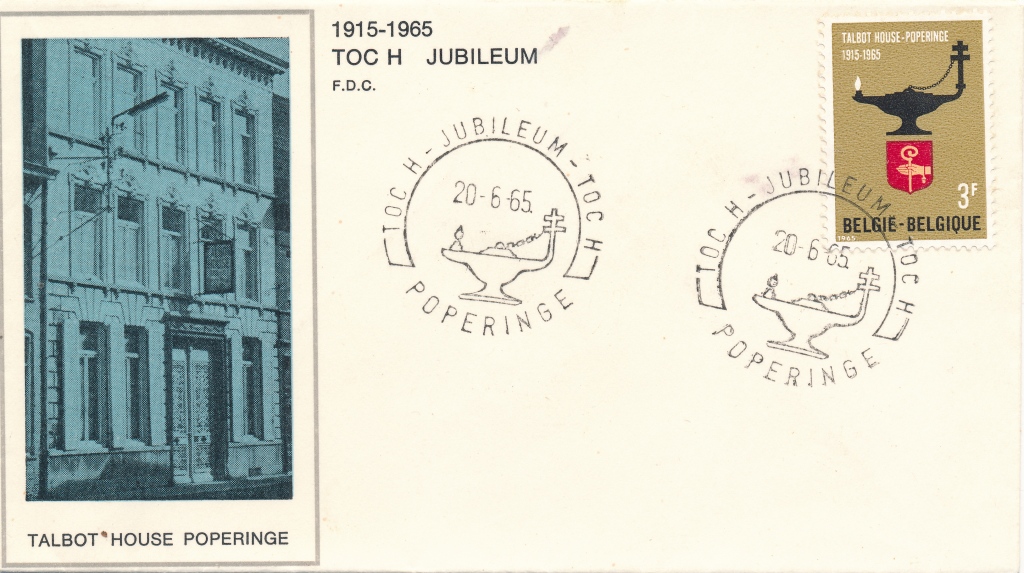
The Begian stamp and First Day cover (1965)
It seemed the whole town joined in: the two lace schools and the art school held exhibitions and concerts; the Post Office even issued a special 3 Frank stamp and accompanying First Day Cover; a commemorative plate was produced; and a new road was even named Toc H Straat. There were battlefield tours and other trips but the pinnacle of the events was probably the Garden Party at Talbot House. And the highlight of this event, the magnificent cake, although the 80 strong Youth Band of St. Stanislas’ College were well received too.
At a reception in the Town Hall, Tubby was made a Freeman of Poperinge, the first for forty years. He also received the Medal of Honour, from Ieper’s Burgomaster, the highest degree the city could offer.
The Westhoek Heritage Centre hold this photo of the event
There was, of course, attendance of the Last Post at the Menin Gate, and afterwards Tubby addressed the crowd from the Ramparts. A Sunday Te Deum at St Bertin’s was followed by fireworks in the Market Place.
Monday was reserved for quiet trips to Kemmel, and Sanctuary Wood where prayers were held at Gilbert Talbot’s grave.
Eucharist was held in the Upper Room, no less than five times so all who wanted to attend could. Poperinge did Toc H proud. Other events included an International Volley Ball Tournament; wreath laying at the Poperinge War memorial; and more. Fortunately, some of the guests filmed lots of the trip and this has been digitized and is available here.
The Poperinge street named for Toc H (1965)
It would be another long wait until the next national Festival as the decision had been made to now only hold one every five years. Thus the 20th and 21st of June 1970 were scored in the diary for Festival ’70.
It was to follow a fairly traditional template: a Thanksgiving Service at Westminster Abbey at noon on Saturday followed by freedom to roam the Tower of London. A festival evening at the Royal Albert Hall on Saturday night. Open house at the Marks on Sunday, then a closing service at All Hallows.
The weather was kind to Toc H on this occasion and after the Westminster service, the crowds milled around the moat in the Tower, catching up with old friends. The lucky few who reserved tickets, had tea at John Barker’s store in Kensington whilst the others snacked in various eateries about London before heading for the Royal Albert Hall.
John Hull gave an organ recital prior to the evening commencing, and played a fanfare to mark its start at 7pm. After Sandy Giles welcomed all, a John Hull composed musical, Newman – A Fantasy was performed. It was described as a journey through life on a steam train. Hull wrote the music and conducted whilst Keith Rea provided the lyrics. The New Anglian Singers and the Massed Choir of Toc H provided the voices. Rea was the Financial Secretary of Toc H (later BAOR Commissioner and International Secretary), whilst Hull was a staff Padre but was well-known in Toc H for his musical bent. Amongst other things he formed the St John’s Singer in 1962 when he started a curacy at St John’s, Great Clacton. They later morphed into the New Anglian Singers.
The Ceremony of Light was followed by a dance called simply Light. This was created by Dora Bullivant (whom we met here [Link]) with assistant from Keefe West, a Jamaican actor and dancer. The dancers were a mix of professionals and young people.
Amidst the entertainment were speeches that focussed on the five-year plan Toc H had drawn up.
Sunday’s service at All Hallows, a Eucharist, was held outside in the church gardens. There was, once again, an art exhibition in the Tate and Lyle Room of 41 Trinity Square.
The fundamental difference was that this was the first Festival since the Central Council ratified the changes to the Royal Charter that meant women could now join Toc H and a separate women’s movement was no longer necessary. This is perhaps a good point to own up that I failed to mention the women’s Festivals so far. I am conscious that I need to write more about the LWH (or Women’s Association) in general but I will get to it in good time. However, Festival ’70 was the first Festival of the joint Movement which made it a remarkable moment in Toc H history.
The other significant thing about Festival ’70, although no-one knew it at the time, was that it would be Tubby’s last.
1975 would also be noteworthy, being the Diamond Jubilee. The Jubilee festival was scheduled for 31st May and 1st June 1975.
Various tickets to Diamond Jubilee Events (1975)
It began, of course, with a Saturday afternoon service at Westminster Abbey. A trumpet blast from the nave heralding the start. The Dean of Westminster led the service and Ken Bloxham delivered the sermon. Lessons were read by those representing Toc H overseas and gave the service a truly international flavour.
1975 Order of Service (Westminster Abbey)
1975 Generic Order of Service for Branches and Districts
Numbers were lower than previous years – Toc H’s slow decline was underway – and so, for the first time in many years, the Royal Albert Hall was deemed too large and expensive. Instead, the Festival evening was held in Westminster Central Hall. It began with an organ recital after which Gilbert Francis took Light. Ken Prideaux-Brune, the Director, welcomed everyone. This led on to a programme of music and readings varying from movements from Holtz’ Planet Suite to readings from Tales of Talbot House. There was a new anthem in Song For Jubilee, sung to the tune of John Brown’s Bodywith new lyrics by John Mitchell.
After an interval, various Toc H entertainment troupes (The New Anglian Singers, the Toc H Minstrels, Anstey Toc H Concert Band, and the Chelmsford dancers) provided further entertainment. The evening closed with hymns.
The whole evening was devised by John Hull and Ken Prideaux-Brune. Ken had this to say about the evening:
The moment which sums up Toc H for me is the close of the first half of the Festival evening which John Hull and I put together in 1975. It came to a climax with a profound poem on the Crucifixion and then, in darkness, the organist played, quietly and reflectively, The Battle Hymn of the Republic. In the darkness the stage filled with the members of the staff. Almost imperceptibly the music got louder and, as it changed into John Brown’s Body, the lights came up and the staff led the audience in the singing of a silly song. That ability to move from the serious to the humorous, without strain or incongruity, is what I treasure most about Toc H. There is something profoundly spiritual about laughter.
There was an exhibition celebrating 60 years of Toc H, and Mill Hill branch laid on films all day in the smaller rooms at Westminster Hall.
Incidentally, the Chelmsford Dancers were choreographed by Dame Elizabeth Twistington-Higgins. Trained as a ballet dancer, she contracted polio in her early twenties and was confined to a wheelchair, and only able to move her head. Despite this she taught herself to paint using her mouth, and trained and choregraphed a group of dancers – the Chelmsford Dancers. A pioneer of the use of ballet in worship, it was how she expressed her own Christianity. A Vice President of Toc H, her life story is told in the 1980 documentary, The Dance Goes On, which was narrated by Rudolf Nureyev
Elizabeth Twistington-Higgins
The Minstrels were from the Mansfield area, formerly known as the Mad Hatters, and formed in 1963. By 1975 they comprised Joan and Bill Bailey, and Lilian and Aubrey Slack.
On Sunday, Communion was again held outside All Hallows in the garden. The intended preacher, Cuthbert Bardsley, was unwell and so Colin Cuttell stood in. Ministers of the various churches took part, including the Dean of Poperinge, who gave a Blessing.
There was a sizable party over from Pops and they joined members from Wolnzach, their twinned town in Bavaria, on a trip down the Thames. A British party went out to Poperinge shortly after the Festival, to celebrate the Diamond Jubilee in Belgium.
The 1980 National Festival would not only follow a similar pattern to 1975 but would fall on the same dates – Saturday 31st May and Sunday 1st June. Westminster would provide the key venues again with Westminster Hall home to the Festival Evening. However, the Service was to be held at Westminster Cathedral (the Roman Catholic church) and not the traditional Abbey. The overall theme of Festival 1980 was to give thanks for all the good things that had happened to Toc H in the five years since the Diamond Jubilee.
It is important to note that 1980 was a Festival Year and events were planned by various branches and groups throughout 1980. The focal point was to be the weekend at the end of May/beginning of June though the celebrations got underway the preceding week with an International Week at Cuddesdon giving overseas visitors the chance to meet before the Festival proper.
The Westminster Cathedral Service on Saturday afternoon was preached by Norman Motley, former Chief Anglican Padre at Toc H and now vicar of St Michael’s Cornhill. It included a liturgical ballet choregraphed by Elizabeth Twistington-Higgins.
At the Festival evening, entertainment was once again to the fore. Some of the acts were ‘fed’ to the Festival from the Arts Festivals that had taken off, particularly at Dor Knap. Since this article deals specifically with the annual national (formerly Birthday) Festivals, I will cover the Arts Festivals later in the year when I write about Toc H entertainment groups. But one example of act who proved popular at the Cotswolds Festival and so were asked to perform at the Festival evening, were the Latvian Dancers.
The evening was actually opened by Southampton’s Magpies who performed the Beatles’ All You Need Is Love. Folk duo Martin and Christine Wenham, also veterans of the Cotswolds Festival, were well received, as was a calypso from Dinnington TAG (Toc H Action Group).
There was a Family Gathering on Sunday afternoon in Westminster Central Hall, before which there was much milling around Tower Hill and the Tower Moat. Here the tea vans from BAOR were on hand to provide refreshments.
In 1985 it was decided to try something a little different, and, although I have said I will talk about the Arts Festivals in another blog, it was probably them, along with traditional British summer fetes, that inspired this Festival. The 1985 Midsummer Festival was convened to celebrate three things: The Centenary of Tubby’s birth; the 70th anniversary of Toc H; and the International Year of Youth. It was to be held at Cuddesdon House near Wheatley in Oxfordshire on the 22nd and 23rd of June.
Early publicity promised an Ox roast, tug o’ war, barn dance, tombola, sideshows, mystery plays, singers, bands, art, crafts, drama, poetry and much more. It was to be a family-centred weekend. In fact, it was to include Kinderfest, an event within the event, especially for children. The Plus Bus, a double-decker converted into a mobile play bus was on site, and Leicester Toc H brought a bouncy castle (it begs the question ‘why did Leicester Toc H have a bouncy castle, and what were their branch meetings like’?). Don Lockhart’s legendary Bentley was also in attendance, no doubt giving rides to those who desired them.
Like all Festivals, it was a chance to catch up with old friends, assuming you could recognise them if they had partaken in the face-painting. And, like all Toc H Festivals, there was of course a Thanksgiving Service.
It was a brave experiment in an attempt to breathe new life into the Festival (and dare I say into Toc H itself) but the location made it difficult for many to get there, and the writing was on the wall for full scale national Festivals.
By the time the next anniversary rolled around- the 75th in 1990 – it was to be a simpler affair. The entire year was turned over to celebrating but it was largely left to districts, areas, and branches to fly the flag and hold events. HQ did provide a range of merchandise – two pottery mugs sit beside me as I write this – ranging from pens to sweatshirts.
At All Hallows, on Friday 7th December, there was an Advent Carol Service followed by a reception at the Guildhall.
The following day at 12noon, a Thanksgiving Service was held at St Martin-in-the Fields, a church long associated with Toc H thanks to the likes of Dick Sheppard and Austen Williams. Toc H had almost gone full-circle, back to celebrating the Birthday in December.
1990 Order of Service (St Martins in-the-Fields)
1990 Generic Order of Service for Branches
For the 80th Anniversary, things were largely decentralised with branches and districts encouraged to create their own events with an aim to promoting awareness of Toc H. Events were spread across 1995 were promoted, starting with a poetry competition. The celebratory year officially began with the World Chain of Light in December 1994 and along the way there was a Toc H Lecture on Reconciliation delivered by Lord David Owen on board HMS Belfast in April; a Garden Party at the Wendover HQ on 24th June; and of course, lots of local exhibitions, events, and parties.
I first became involved with Toc H in 1988 through the youth club at Cuffley where I volunteered. The centre was used by the local Toc H for various projects and we formed a liaison taking the young people out to Talbot House for the first time in 1990. In 1995, for the 80th Birthday Celebrations, we did our first big project for Toc H, creating and performing a show called 80 Years of Toc H. It was a huge success and must have done much locally for reviving the Toc H name. It was this sort of project across the country (and overseas) that made these celebrations such a success. It was very different to that first birthday party back in 1921.
Would it be repeated for the 85th Anniversary in five years’ time? Unfortunately, 2000 was a time of great upheaval at Toc H. The sudden death of a popular Director, Mike Lyddiard, in March 1999, had left Toc H reeling, and though a new appointee had arrived, it was not an appropriate time to celebrate. There were some events at a local level though not as many as in 1995. Nationally, the Carol Concert in December included a small birthday celebration, and a party went out to Talbot House for the World Chain of Light (which began at Lindridge House in Devon). It was though, a somewhat muted year.
And the 90th Birthday celebrations in 2005 were also lacklustre. Sad to say, Toc H was in freefall by then and a shadow of its former self. A handful of local events were arranged but the main focal point nationally was a Thanksgiving Service at Coventry Cathedral on Saturday 25th June.
2005 Order of Service (Coventry)
And that – at least to date – was really the last of the UK organised Birthday celebrations. Thankfully, there was still to be a huge party for the centenary in 2015. Organised by Poperinge Toc H and Talbot House, I was very fortunate to be there
It began on Thursday 10th December 2015 with a tour of Poperinge including Ljissenthoek Cemetery. On Friday there was a service at St Bertin’s followed by a civic reception at the Town Hall. In the evening, the exact centenary of the opening of Talbot House, there was a birthday party held in the garden of the Old House (under canvas). Just before 8pm, the Toc H element (there were people from various Belgian organisations present) crept up to the Upper Room where we started the World Chain of Light, before returning for the party and the obligatory cake.
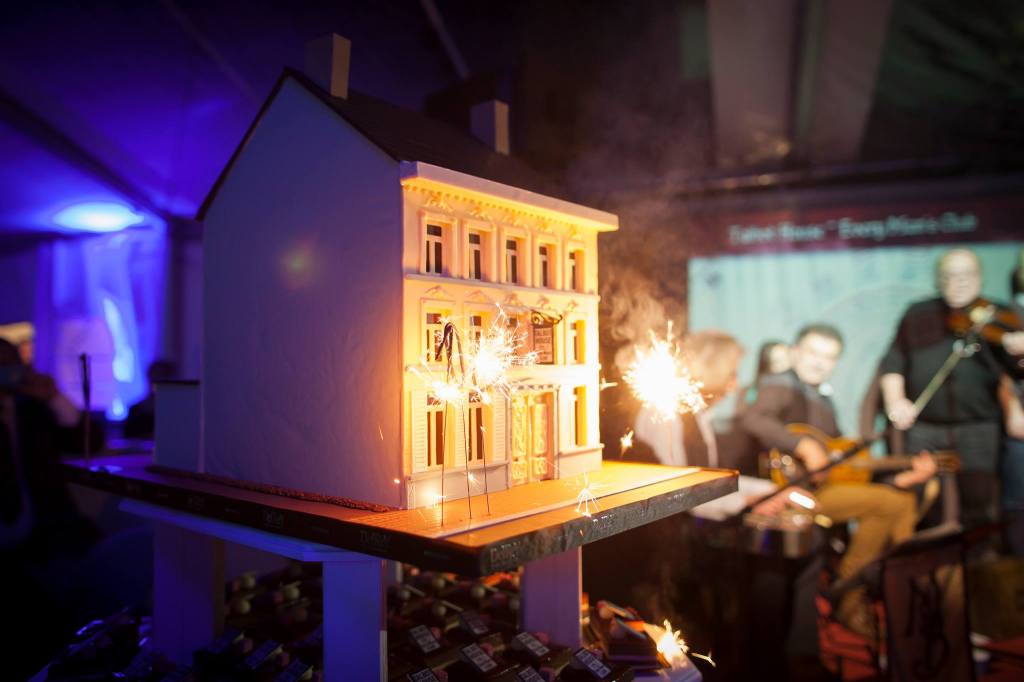
Yes, this was really made of cake (2015)
On Saturday, we all took turns to sit vigil for the WCOL, and visit various workshops around Talbot House when we were free. The evening started with a concert party and then we had the closing ceremony for the chain.
Sunday was a day long battlefield tour which, after dinner in Ieper, concluded with the Last Post at the Menin Gate. The Ceremony of Light, led by Ken Prideaux-Brune, was held under the Gate, I believe, for the first time ever (though I will be happy to stand corrected on that point).

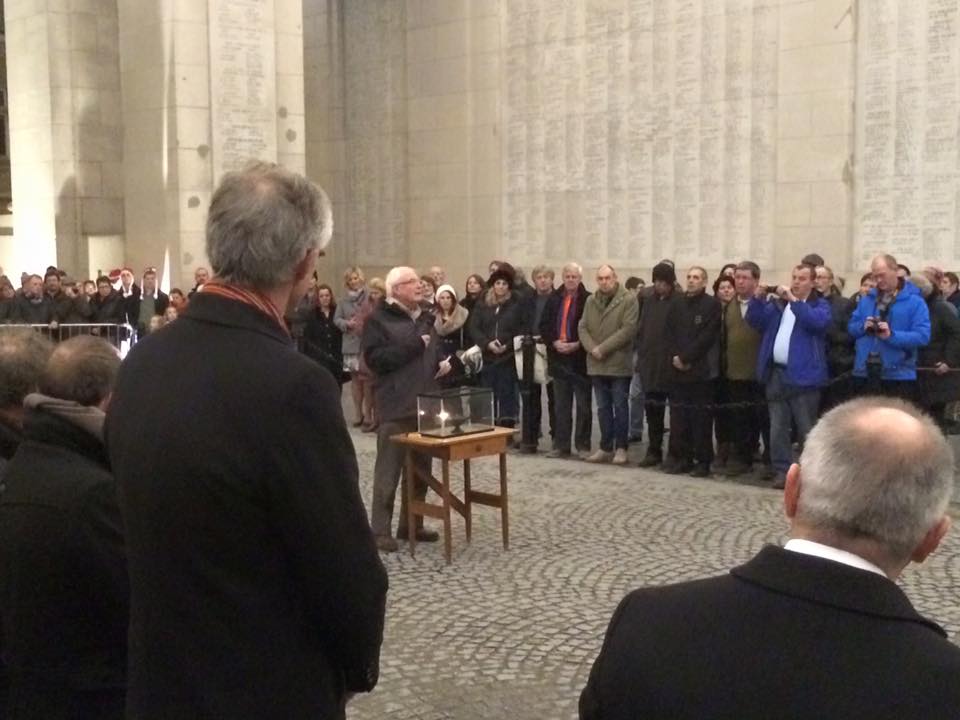
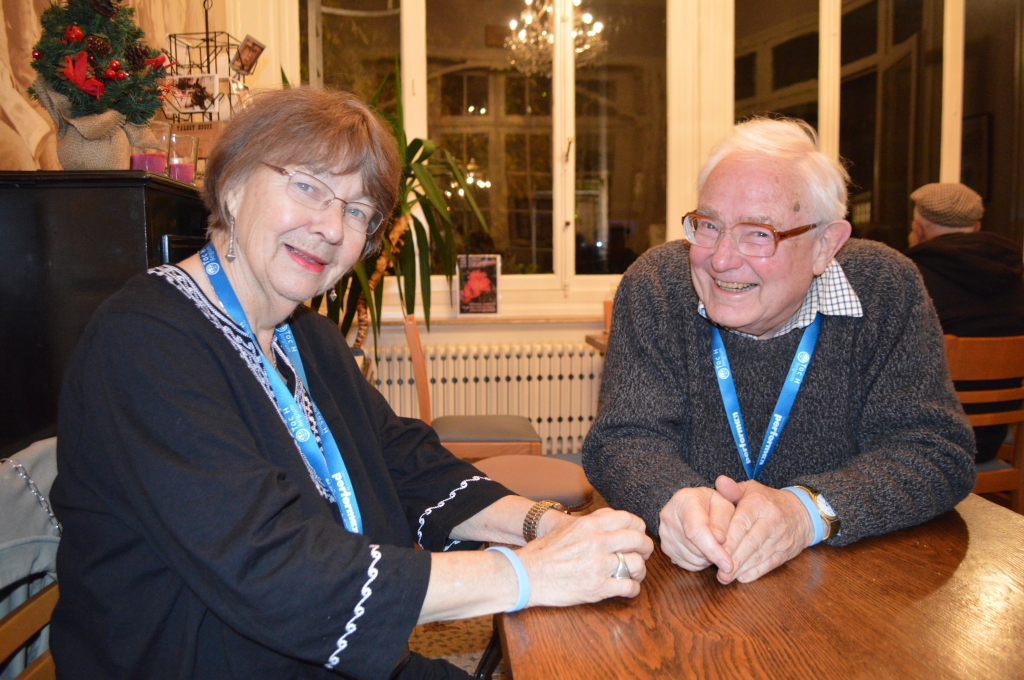
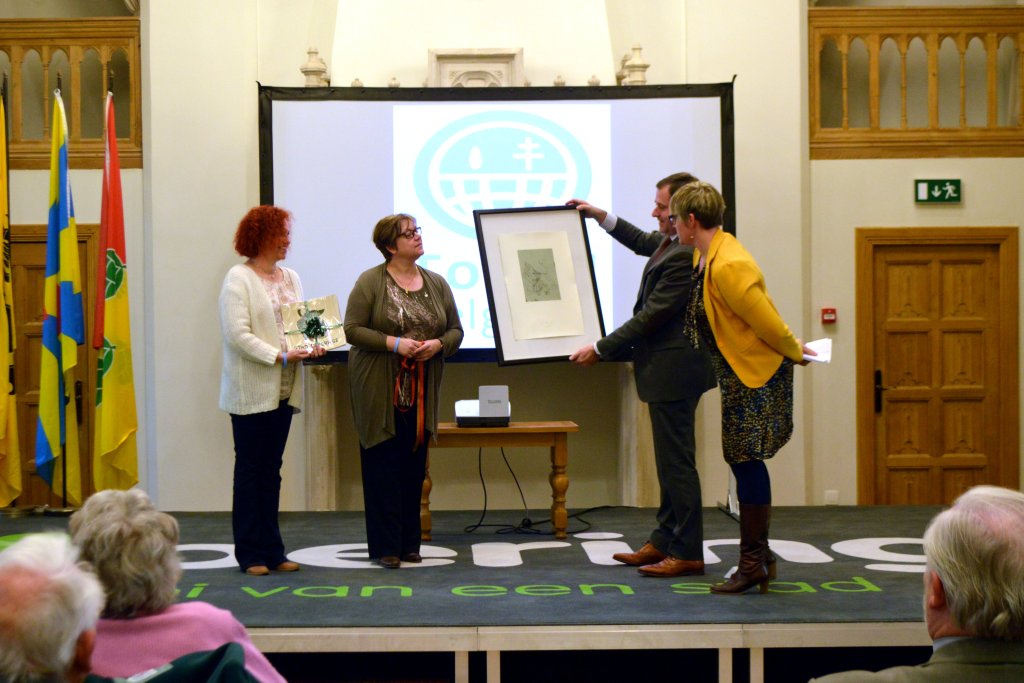
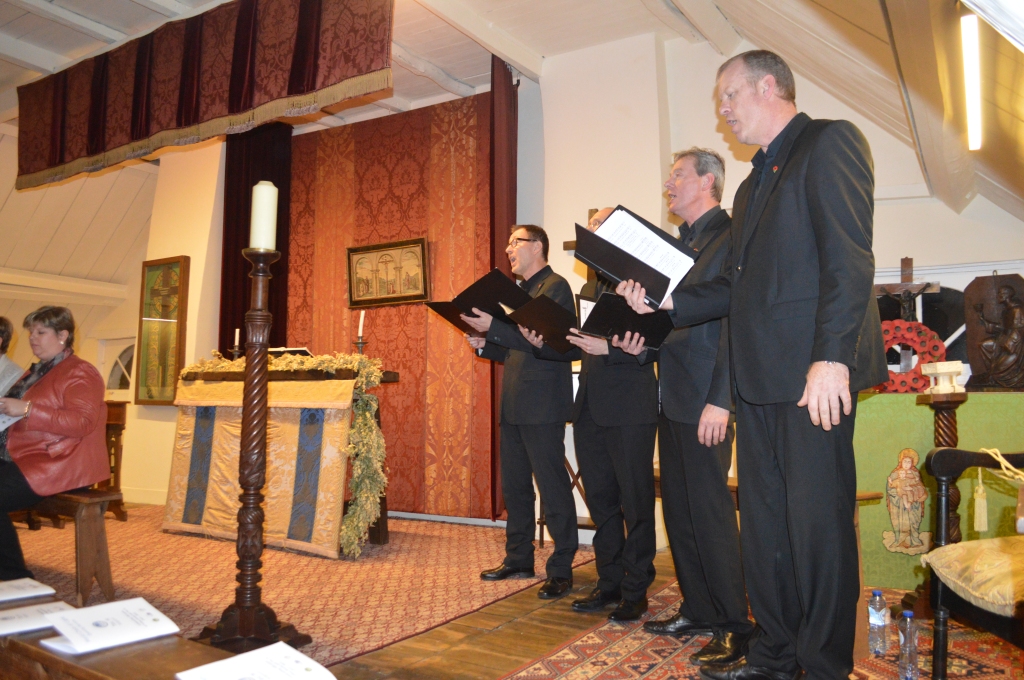
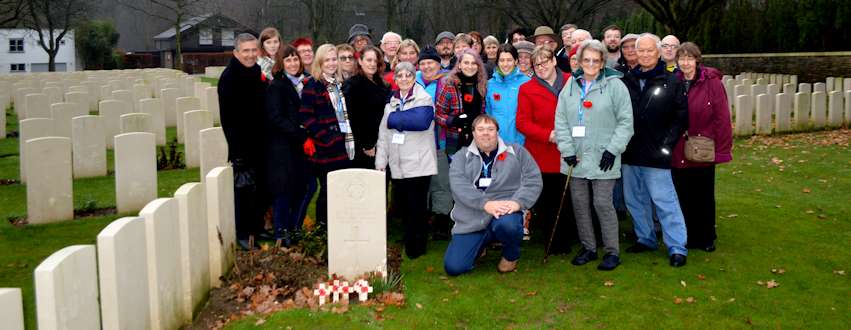
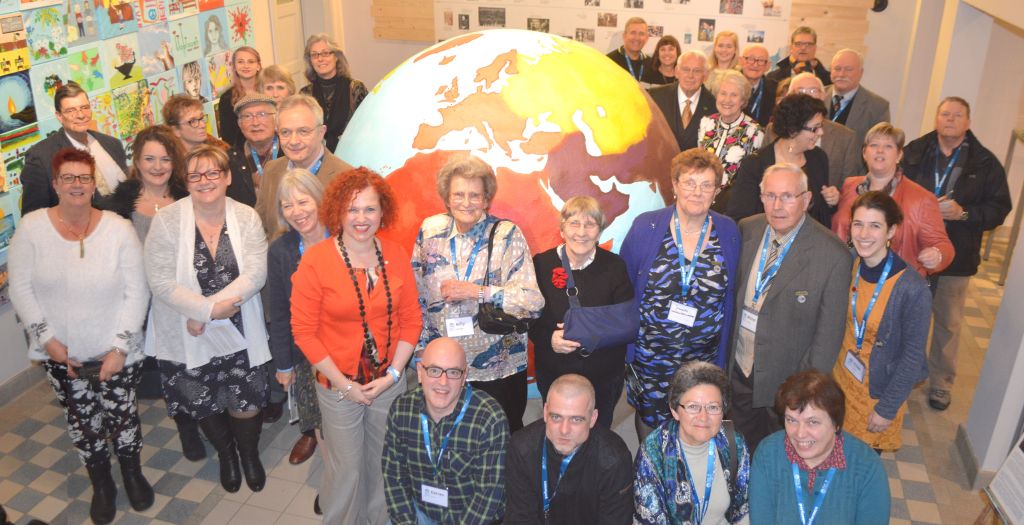
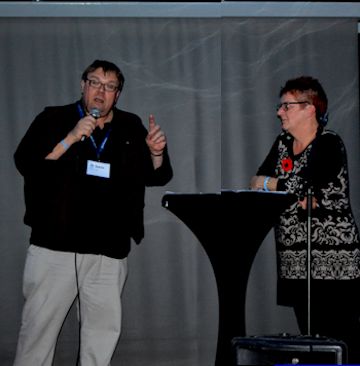
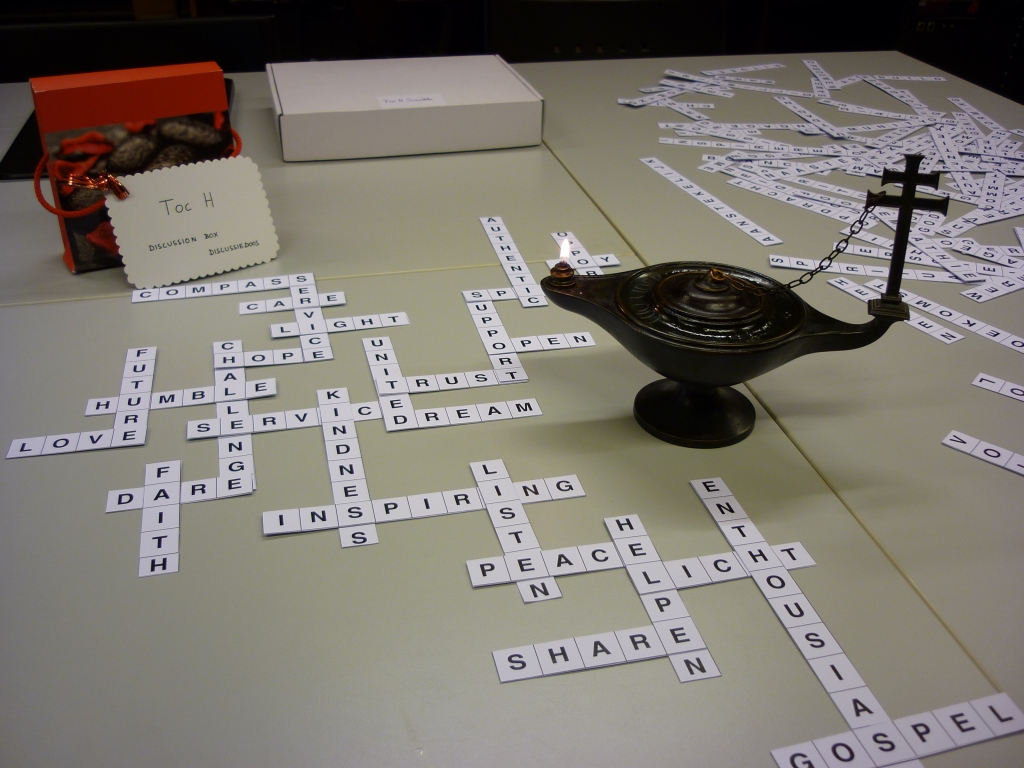
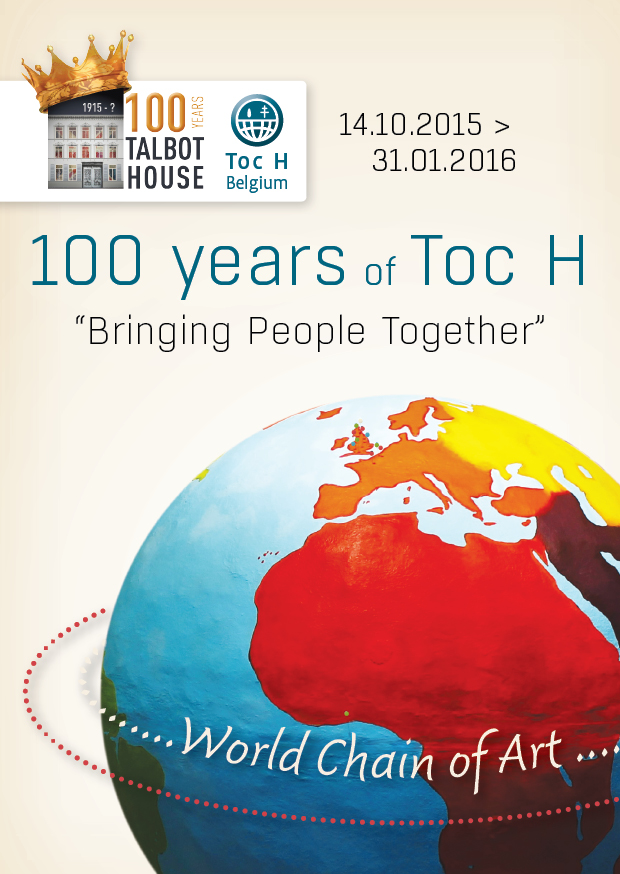
A selection of photos from the 2015 celebrations
On Monday 14th, after a lovely brunch, day one of the International Conference was held. And International it was! As well as us Brits and our Belgian friends, I was delighted to spend the long weekend with new friends from Australia, and South Africa, even though one of the South Africans gave us quite a scare by having a heart attack in the dining room at Talbot House (he recovered well and was back at the conference the following day). The evening entertainment was a light-hearted quiz which I’m sure we took way too seriously.
On Tuesday there was a Round Robin Ceremony in the Upper Room where all present signed a new document recording their visit. Such a pity that the original Round Robin is still missing. Day two of the conference took place in the afternoon and included the signing of documents of co-operation between Toc H and Talbot House. The entire event closed with a play in the evening.
These few paragraphs do not do justice to either the work put in by the organisers, nor to the incredible enjoyment those of us attending got from the few days.
I was as joyous and privileged to be there in 2015, as those early members were to be at Grosvenor House in December 1921.
